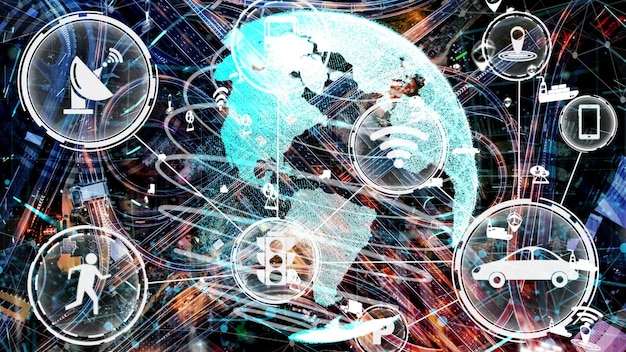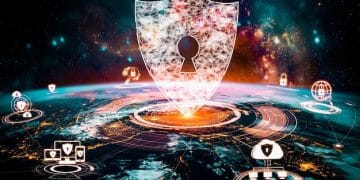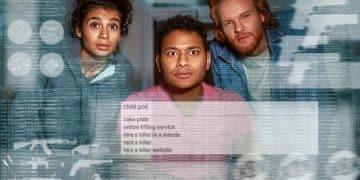Combating Disinformation: New Tech Tools for 2026 US Elections

Combating Disinformation: New Tech Tools and US Government Initiatives for the 2026 Elections involves deploying advanced technologies and strategic policies to identify, counter, and mitigate the spread of false or misleading information, ensuring a more informed electorate.
The integrity of US elections is increasingly threatened by the proliferation of disinformation. Combating Disinformation: New Tech Tools and US Government Initiatives for the 2026 Elections will be crucial in safeguarding democratic processes. This article explores innovative technologies and governmental strategies designed to counter these threats.
From AI-driven fact-checking to sophisticated social media monitoring, how are these cutting-edge tools being deployed? And what role will government initiatives play in ensuring a fair and accurate electoral landscape? Let’s delve into the measures being taken to protect the 2026 elections from the dangers of disinformation.
Understanding the Landscape of Disinformation in US Elections
Disinformation poses a significant threat to the US electoral system, undermining public trust and potentially influencing election outcomes. Recognizing the evolving nature of this threat is the first step in combating disinformation effectively. With advancements in technology, the methods and scale of disinformation campaigns have become increasingly sophisticated.
The Rise of Deepfakes and Synthetic Media
One of the most alarming developments is the rise of deepfakes and other forms of synthetic media. These technologies can create highly realistic but entirely fabricated videos and audio recordings. Imagine a deepfake video of a candidate making inflammatory statements or appearing to endorse false information. Such content can spread rapidly online, causing significant damage before it can be debunked.
Social Media Amplification of False Narratives
Social media platforms have become primary vectors for the spread of disinformation. Algorithms designed to maximize engagement can inadvertently amplify false narratives, especially those that provoke strong emotional reactions. This creates echo chambers where users are primarily exposed to information confirming their existing beliefs, making them more susceptible to manipulation.
- Bot Networks: Automated accounts that spread disinformation and create the illusion of widespread support for certain viewpoints.
- Foreign Interference: Coordinated campaigns by foreign entities to influence US elections through the dissemination of false or misleading information.
- Hyper-Partisan Content: Extremely biased or one-sided news sources that prioritize ideological goals over factual accuracy.
Understanding these different facets of the disinformation landscape is essential for developing effective countermeasures. The 2026 elections will require a multi-pronged approach, combining technological solutions with media literacy education and policy interventions. The goal is to create a more resilient and informed electorate capable of discerning fact from fiction.

New Tech Tools for Combating Disinformation: 2026 Elections
Technological innovation is at the forefront of efforts to counter disinformation. Various new tools are being developed and deployed to identify, analyze, and mitigate the spread of false information. These technologies range from AI-driven fact-checking systems to sophisticated social media monitoring platforms. Here, we will explore some of the most promising new tech tools that may become important for combating disinformation.
AI-Powered Fact-Checking and Verification
Artificial intelligence (AI) plays a crucial role in automating the fact-checking process. These AI systems can analyze text, images, and videos to identify potential falsehoods, inconsistencies, and manipulated content. By comparing information against credible sources and detecting patterns associated with disinformation, they can quickly flag suspect content for further review.
Advanced Social Media Monitoring
Monitoring social media platforms for disinformation requires more than just tracking keywords. Advanced systems use natural language processing (NLP) and machine learning (ML) to analyze the context and sentiment of posts, identify bot networks, and detect coordinated disinformation campaigns. These tools provide valuable insights into how disinformation is spreading and who is behind it.
Some additional tools that are important are:
- Blockchain Technology: Used for verifying the authenticity and provenance of news articles and other information.
- Decentralized Social Networks: Platforms that prioritize user control and transparency, making it more difficult for disinformation to spread unchecked.
- AI-Driven Content Moderation: Automated systems that can identify hate speech, incitement to violence, and other forms of harmful content.
These new tech tools hold great potential for combating disinformation, but they are not without challenges. Ensuring accuracy, avoiding bias, and protecting user privacy are critical considerations in their development and deployment. Moreover, technology alone cannot solve the problem or guarantee the integrity of elections.
US Government Initiatives for the 2026 Elections
The US government is actively engaged in efforts to counter disinformation through a range of initiatives involving multiple agencies and branches. Legislative measures and public awareness campaigns are crucial components. A whole-of-government approach is necessary to address the multifaceted threat of information warfare.
Legislative Actions and Policy Frameworks
Congress are introducing new laws focused at increasing transparency for on-line political advertisements. These laws are built to unveil the funding and origins of messages to forestall concealed impacts. Initiatives also extend to enhancing cybersecurity for election structures and encouraging collaboration among government our bodies and technology corporations and improving the guidelines associated with combating disinformation.
Public Awareness and Media Literacy Campaigns
Government tasks are designed to empower the public with the skills to critically evaluate news and information and avoid misinformation. These initiatives include workshops, online resources, media literacy programs, and collaborations with educational institutions.
- Cybersecurity Initiatives: Protecting election infrastructure from cyberattacks and ensuring the integrity of voter registration databases.
- International Partnerships: Working with allied countries to share information and strategies for combating disinformation.
- Support for Independent Journalism: Providing funding and resources for investigative reporting and fact-checking organizations.
These government initiatives is important to promote a more informed public discourse and protect the integrity of the electoral process. The effectiveness of these measures, however, depends on sustained commitment, collaboration, and adaptation to the evolving challenges posed by disinformation campaigns. When all these components come together, then real combating disinformation starts.

Challenges and Limitations of Current Approaches
Despite significant advancements in technology and policy, there are numerous challenges and limitations in the current approach to combating disinformation. These challenges must be addressed to create a more resilient and effective defense against information warfare.
The Speed and Scale of Disinformation
One of the biggest problems is the pace and scale at which disinformation can spread on-line. Rapid distribution makes it difficult to get information quickly enough. By the time are debunked, millions of people may additionally have already seen it. This calls for faster reaction times and efficient strategies to prevent falsehoods to start with.
Evolving Tactics of Disinformation Actors
Disinformation actors are constantly evolving and adapting their techniques to evade detection. Using AI, bots, and coordinated inauthentic behavior to make it hard for people to detect malicious attacks. The approaches have to be improved to live ahead of these changes.
- Bias and Accuracy Concerns: Ensuring that fact-checking systems are accurate and unbiased to avoid inadvertently censoring legitimate speech.
- Privacy Considerations: Balancing the need for monitoring and analysis with the protection of user privacy and civil liberties.
- Lack of Public Trust: Overcoming skepticism and mistrust in government and media to effectively convey accurate information.
These challenges require a continuous process of innovation, adaptation, and collaboration between technology companies, government agencies, and civil society organizations. The goal is to create a more resilient and informed public capable of discerning fact from the fiction and resisting manipulation. Only working together we can enhance combating disinformation.
The Future of Combating Disinformation: 2026 and Beyond
The future of combating disinformation will require a more holistic approach that integrates technological solutions with media literacy education, policy interventions, and international collaboration. Emerging technologies and data-driven results will be crucial. The upcoming years will shape how disinformation is addressed.
As we look forward to the 2026 elections and beyond, it is clear that combating disinformation will remain a critical challenge for democracies around the world. The convergence of technology, policy, and education will be important for improving election integrity.
Embracing a Multi-Stakeholder Approach
What should be improved that will impact and help for upcoming years:
- Enhanced Media Literacy Education: Equipping citizens with the skills to critically evaluate information and identify disinformation.
- International Cooperation: Working with allied countries to share information and strategies for combating disinformation.
- Ethical AI Development: Ensuring that AI systems used for fact-checking and content moderation are accurate, unbiased, and transparent.
By focusing on these key areas, we can build a more resilient and informed society. Only through sustained effort and cooperation can we hope to safeguard the integrity of our elections and preserve the foundations of democracy. We must stay ahead to combatting disinformation.
| Key Point | Brief Description |
|---|---|
| 🛡️ Tech Tools | AI and social media monitoring help identify and counter disinformation. |
| 🏛️ Government Initiatives | Legislation and public campaigns aim to promote media literacy. |
| 🌐 Challenges | The rapid spread of disinformation and evolving tactics pose hurdles. |
| 🔮 Future | Holistic approaches and international cooperation are vital for the future. |
FAQ
AI-powered fact-checking systems and advanced social media monitoring tools are being deployed. AI helps automate fact-checking, while social media monitoring tracks disinformation campaigns.
Government initiatives include legislative actions to increase transparency of online political ads, media literacy campaigns, and cybersecurity enhancements for election infrastructure.
The speed and scale of disinformation spread and the constant evolution of disinformation tactics are major challenges. Also, maintaining public trust and addressing ethical concerns are important.
Media literacy empowers citizens to critically evaluate information and spot disinformation. This includes recognizing fake news, manipulated content, and biased reporting, improving their ability to make informed decisions.
The future involves a holistic approach with technology, education, and international cooperation. Ethical AI development and continuous innovation are key to safeguarding future elections from disinformation.
Conclusion
Combating Disinformation: New Tech Tools and US Government Initiatives for the 2026 Elections faces an uphill battle against the tide of false narratives and manipulated content. Addressing these challenges requires multi-pronged strategies, combining innovative tech with policy changes and public education.
By empowering citizens, improving technology, and expanding government initiatives, the electoral process can be protected from the harms of disinformation. Collaboration between individuals, organizations, and governments is essential to guarantee the integrity of elections well into the future.





